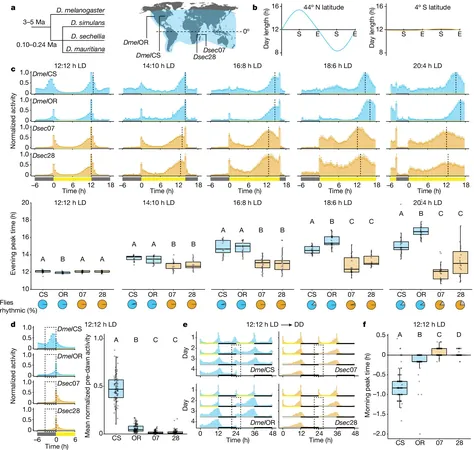
Unraveling the Secrets of Circadian Plasticity: How Flies Adapt to Changing Environments
2024-10-31
Author: Rajesh
Introduction
Recent research has shed light on a fascinating aspect of biology: the genetic basis for circadian plasticity in flies. A team led by Professor Richard Benton at the University of Lausanne has published groundbreaking findings in the prestigious journal Nature, revealing how certain species of fruit flies, specifically Drosophila, have developed the remarkable ability to adapt their behavior in response to varying day lengths.
As organisms navigate a world filled with environmental fluctuations, their survival hinges on a trait known as behavioral plasticity—the capacity to adapt actions based on surrounding conditions. Humans, along with various other species with wide geographical ranges, rely on this adaptability to thrive in diverse habitats. However, the underlying molecular mechanisms that drive such plasticity have remained elusive.
Circadian Cycles and Day Length Adjustments
Day length varies significantly depending on various factors such as season and geographic location. Many species, including specific types of fruit flies, have evolved to synchronize their circadian rhythms—essentially their daily activity cycles—to these changes. The research team conducted experiments comparing two Drosophila species: Drosophila melanogaster (the vinegar fly), known for its global distribution and ability to adapt, and Drosophila sechellia, a species limited to the Seychelles with lesser variations in light periods.
In their research, the scientists imposed a 16-hour light cycle—a condition that would be considered "long days"—to observe how each species adapted. The results were striking: D. sechellia, accustomed to a stable 12-hour day, struggled significantly, experiencing a halved reproductive rate due to the stress of adapting to these extended photoperiods. In contrast, D. melanogaster managed to maintain its fertility, showcasing its superior circadian plasticity.
Discovering Key Genetic Drivers
A critical breakthrough came through genetic screening, revealing the pivotal role of the Pdf (Pigment-dispersing factor) gene. This gene is crucial for the expression of neuropeptides that regulate circadian behaviors. When D. melanogaster's Pdf gene was swapped with that of D. sechellia, its ability to adapt to longer daylight hours diminished, illustrating just how significant these genetic differences are for survival.
Professor Benton noted that the unique features of the Pdf gene in D. melanogaster have undoubtedly contributed to its widespread success across various environments, while D. sechellia remains confined to its niche.
The Bigger Picture: Behavioral Plasticity in Nature
These findings not only highlight the role of the Pdf neuropeptide in fruit flies but also open avenues for further exploration into behavioral plasticity across other species. Benton points out past research indicating that species residing in higher latitudes may exhibit even greater flexibility in their circadian activities, suggesting that the Pdf neuropeptide could be a key evolutionary instrument in shaping adaptability.
Moreover, the implications extend beyond fruit flies. Since Pdf is present in many arthropods, including widely distributed species like mosquitoes, it raises intriguing questions about the potential role of this neuropeptide in the behavioral adaptations of various organisms.
As scientists further investigate the molecular mechanisms behind behavioral plasticity, we may gain profound insights not only into the adaptive capabilities of fruit flies but also into how other animals—including songbirds, which alter their vocalizations in noisy human environments, and lizards, which modify their behaviors based on altitude—respond to the pressures of their changing habitats. This research could fundamentally reshape our understanding of evolutionary biology and the survival strategies of species facing a rapidly changing world.
Stay tuned as we track more discoveries that pinpoint the intricate dance between genetics and behavior in the animal kingdom!



 Brasil (PT)
Brasil (PT)
 Canada (EN)
Canada (EN)
 Chile (ES)
Chile (ES)
 Česko (CS)
Česko (CS)
 대한민국 (KO)
대한민국 (KO)
 España (ES)
España (ES)
 France (FR)
France (FR)
 Hong Kong (EN)
Hong Kong (EN)
 Italia (IT)
Italia (IT)
 日本 (JA)
日本 (JA)
 Magyarország (HU)
Magyarország (HU)
 Norge (NO)
Norge (NO)
 Polska (PL)
Polska (PL)
 Schweiz (DE)
Schweiz (DE)
 Singapore (EN)
Singapore (EN)
 Sverige (SV)
Sverige (SV)
 Suomi (FI)
Suomi (FI)
 Türkiye (TR)
Türkiye (TR)
 الإمارات العربية المتحدة (AR)
الإمارات العربية المتحدة (AR)